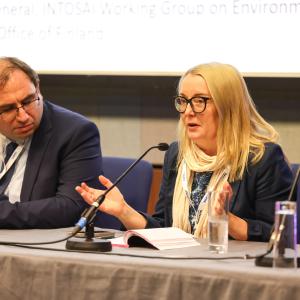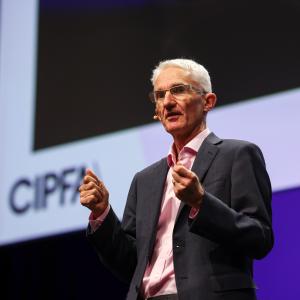Reading reports of the ongoing row between chancellor George Osborne and energy secretary Chris Huhne over the status of the government’s proposed Green Bank bought back anxious memories of my failed history A level; the answer I had carefully prepared in the preceding weeks bore little or no resemblance to the question in front of me.
And I think the government is making the same mistake. The arguments for the Green Bank seems to work as follows: the UK needs to spend upwards of £200bn over the next ten years to meet our statutory target of producing 15% of renewable power by 2020, but the banks and utility companies are not investing anywhere near at the required rate and lots of promising technologies and projects are stalled awaiting capital.
But is this really true and is a government bank the answer? There is no doubt that the level of required investment is huge. There seems to be an arms race among commentators as to who can come up with the biggest scariest number and only today the Times was quoting £3trn of pan European spending in the next ten years. And, yes, the banks are not as willing to invest in the UK as they used to be. This is understandable. The surviving bankers in London are ashen faced with 1,000 yard stares, deeply traumatised by the once-in-a-lifetime events of 2008. They are not about to return to their personal Vietnam of highly leveraged low-margin non-recourse lending any time soon.
But the global picture is more positive. Investment in renewables reached £145bn last year and we expect £150bn plus in 2010, although tellingly only one UK bank featured in the top 20 global lenders. Alongside the banks there are numerous clean tech funds, pension funds and private equity houses that want to invest in anything vaguely green and well developed.
So, maybe the reason some UK renewable energy projects are struggling to get funding is not because there is a global shortage of capital, maybe it’s because they are not very good projects full stop. Evolution and the X Factor both tell us three things: unbridled competition for scarce resources is cruel, makes for easy entertainment on a Saturday night and the good guys always win eventually. An investment banker I know reads 1,000 business cases for renewable projects a year and invests in four viable ones.
My worry for the Green Bank is that it will act like a blind fairy godmother sprinkling its £1bn largesse of taxpayers’ money among the other 996 projects like gentle spring rain. Everybody gets a little bit wet irrespective of merit but not enough to make a difference. Unlike Simon Cowell, the UK government does not have a great track record of picking winners and certainly no better than the global investment community.
So if the answer is not a fairy godmother bank, what should the government do? Firstly, there is a structural funding gap between the promising technologies emanating from our universities and what can be funded. Unlike Che Guevara posters and CND membership, some ideas from your university days are worth sticking with, but the funding market for projects at this stage is very thin. However, large corporations such as BP, Samsung, Siemens and even Google are increasingly active in this space and tare better incubators of embryonic ideas to commercialisation than Whitehall. The government can do a lot to encourage this midwifery through tax breaks and capital allowances, and to my mind this is a better and more subtle use of £1bn.
Secondly the UK planning system does not encourage investment in new technologies. Up to 17.5 Giga watts of projects of renewable projects have been announced but are stalled pending the resolution of planning objections. Put it another way, that’s 26 carbon dioxide producing coal-fired power stations that are being run unnecessarily for years because somebody somewhere does not want the panoramic view from their kitchen window impaired by wind turbines or solar panels on the distant horizon. You would be surprised how many very ‘green’, very famous pop stars are vociferous objectors to planning consents anywhere near their country estates. For the articulate middle classes, renewable power is a bit like reducing car usage, a good idea for everybody else but honestly our circumstances are different.
Thirdly, the government can do a lot to by investing in improved grid connectivity to Europe. One of the problems with renewable power is the Goldilocks nature of the supply; sometimes it’s too windy, sometimes it’s too gloomy and only rarely does the weather correspond to the demands on the grid. However, if we make the grid bigger by stitching in our European cousins, local variability will be less of an issue. As long as it’s sunny or windy somewhere we can benefit here despite the rain.
Finally, the best role for the state is probably manipulating the policy levers of carrots for investment and sticks for carbon dioxide emitters. To be fair, the government has made a lot of headway here and the proposed floor on carbon pricing will push a lot more money into wind and hydro and away from fossil fuels. However, the longevity of the supply of the carrots remains frustratingly vague. The investment community is like baby deer – easily startled by rustles in the bushes – and the announcement of a 2012 review of Feed in Tariffs has made everybody skittish. You cannot expect investors to put their heads down and make multi million pound decisions if you change the rules every three years or so.
So in conclusion, I don’t think the fairy godmother of a green Investment bank is the answer to the renewable funding gap in the UK. We need to be wary of throwing money at voter friendly solutions to symptoms when the underlying causes are more complex than they first appear. There would undoubtedly be a lot more investment in UK renewables if we addressed structural issues in the planning, taxation and subsidy systems although I know this does not play as well on the Today programme as Vince Cable bashing the banks. The £1bn will not go very far towards meeting the 15% renewable power target (it's about one-third of the cost of a single nuclear power station) but it is an awful lot of taxpayers money to waste on the renewable equivalents of Wagner.
Michael Ware is corporate finance partner at BDO











